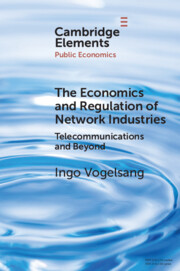Element contents
The Economics and Regulation of Network Industries
Published online by Cambridge University Press: 24 September 2021
Summary
Keywords
- Type
- Element
- Information
- Series: Elements in Public EconomicsOnline ISBN: 9781108775410Publisher: Cambridge University PressPrint publication: 04 November 2021
References
- 3
- Cited by



